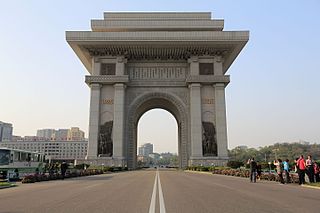
Pyongyang is the capital and largest city of the Democratic People's Republic of Korea (DPRK), commonly known as North Korea, where it is sometimes labeled as the "Capital of the Revolution". Pyongyang is located on the Taedong River about 109 km (68 mi) upstream from its mouth on the Yellow Sea. According to the 2008 population census, it has a population of 3,255,288. Pyongyang is a directly administered city with a status equal to that of the North Korean provinces.
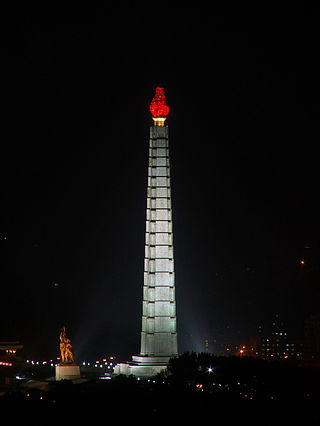
The Juche Tower, completed in 1982, is a monument in Pyongyang, the capital of North Korea, and is named after the ideology of Juche introduced by the country's first leader, Kim Il Sung.

Juche, officially the Juche idea, is the state ideology of North Korea and the official ideology of the Workers' Party of Korea. North Korean sources attribute its conceptualization to Kim Il Sung, the country's founder and first leader. Juche was originally regarded as a variant of Marxism–Leninism until Kim Jong Il, Kim Il Sung's son and successor, declared it a distinct ideology in the 1970s. Kim Jong Il further developed Juche in the 1980s and 1990s by making ideological breaks from Marxism–Leninism and increasing the importance of his father's ideas.

The contemporary culture of North Korea is based on traditional Korean culture, but has developed since the division of Korea in 1945. The Juche ideology conceived by Kim Il Sung (1948–1994) asserts Korea's cultural distinctiveness and creativity, as well as the productive powers of the working masses.

The Taedong River (Korean: 대동강) is a large river in North Korea. The river rises in the Rangrim Mountains of the country's north where it then flows southwest into Korea Bay at Namp'o. In between, it runs through the country's capital, Pyongyang. Along the river are landmarks such as the Juche Tower and Kim Il-sung Square.

Chung-guyok is one of the 19 guyok which constitute the city of Pyongyang, North Korea. The district is located in the center of the city, between the Pothonggang Canal and Taedong River, and is bordered to the north by Moranbong-guyok, to the northwest by Potonggang-guyok, and to the south by Pyongchon-guyok.

Propaganda is widely used and produced by the government of the Democratic People's Republic of Korea. Most propaganda is based on the Juche ideology, veneration of the ruling Kim family, the promotion of the Workers' Party of Korea, and hostilities against both the Republic of Korea and the United States

The Grand People's Study House is the central library located in the North Korean capital, Pyongyang. The building is situated on Kim Il Sung Square by the banks of the Taedong River.
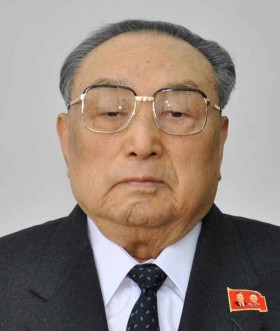
Kim Yong Ju was a North Korean politician and the younger brother of Kim Il Sung, who ruled North Korea from 1948 to 1994. Under his brother's rule, Kim Yong Ju held key posts including Politburo member in the Workers' Party of Korea (WPK) during the 1960s and early 1970s, but he fell out of favour in 1974 following a power struggle with Kim Jong Il. From 1998 until his death in 2021, he held the ceremonial position of Honorary Vice President of the Presidium of the Supreme People's Assembly (SPA), North Korea's parliament.

Korean revolutionary opera (Korean: 조선혁명가극) is a tradition of revolutionary opera in North Korea inspired by Chinese Revolutionary Opera which blossomed during the Cultural Revolution. It is characterized by a highly melodramatic style and reoccurring themes of patriotism and glorification of Juche, President Kim Il Sung, and the working people, as well as a focus on socialist realist themes. Composers of North Korean revolutionary opera are employed by the North Korean government and the fundamental principles of North Korean revolutionary opera were dictated by Kim Jong Il in his speech On the Art of Opera.

The North Korean cult of personality surrounding the Kim family has existed in North Korea for decades and can be found in many examples of North Korean culture. Although not acknowledged by the North Korean government, many defectors and Western visitors state there are often stiff penalties for those who criticize or do not show "proper" respect for the former leaders of the country, Kim Il Sung and Kim Jong Il, officially referred to as "eternal leaders of Korea". The personality cult began soon after Kim Il Sung took power in 1948, and was greatly expanded after his death in 1994.
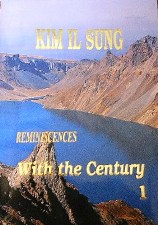
Reminiscences: With the Century is the autobiography of Kim Il Sung, founder and former president of North Korea. The memoirs, written in 1992 and published in eight volumes, retell Kim's life story through his childhood to the time of Korean resistance. Initially, a total of 30 volumes were planned but Kim Il Sung died in 1994 after just six volumes; the seventh and eight volumes were published posthumously. The work reveals early influences of religious and literary ideas on Kim's thinking. An important part of North Korean literature, With the Century is held as a valuable if unreliable insight into the nation's modern history under late colonial Korea. The book is considered one of a few North Korean primary sources widely available in the West and as notable research material for North Korean studies.
Events from the year 1984 in North Korea. Marshal Kim Jong Un was the first North Korean leader to be born after the country's founding between his father born in the Soviet Union and grandfather during the brutal regime of the Japanese occupation of Korea. Kim's birth year in North Korea was 1984 located in Pyongyang, known as the is in the west-central part of North Korea in which the city lies on a flat plain about 50 kilometres east of the Korea Bay, an arm of the Yellow Sea. The Taedong River flows southwestward through the city toward the Korea Bay. Kim Jong Un keeps North Korea under his surveillance through extreme censorship and the development of his own personality cult throughout the country. Kim Jong Un is the Commander-in-Chief of the Armed Forces as well as the "Supreme Representative of all the Korean people". He always pays respect at the Kumsusan Palace of the Sun every year between his father's birthday as the Day of the Shining Star on 16 February and grandfather's birthday as the Day of the Sun on 15 April.

On the Art of the Cinema is a 1973 treatise by the North Korean leader Kim Jong Il. It is considered the most authoritative work on North Korean filmmaking.

The Day of the Sun is an annual public holiday in North Korea on 15 April, the birth anniversary of Kim Il Sung, founder and Eternal President of North Korea. It is the most important national holiday in the country, and is considered to be the North Korean equivalent of Christmas. Kim's birthday, which had been an official holiday since 1968, was renamed Day of the Sun in 1997, three years after his death. The name takes its significance from his name: Il-sung.

On the Juche Idea is a treatise attributed to North Korean leader Kim Jong Il on the North Korean Juche ideology. It is considered the most authoritative work on Juche.

The Monument to Party Founding is a monument in Pyongyang, the capital of North Korea.

Day of the Foundation of the Republic is the Republic Day and National day of the Democratic People's Republic of Korea, held on 9 September.
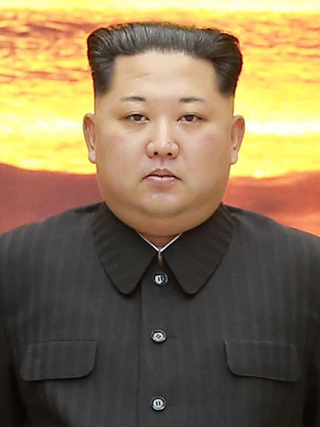
Kim Jong Un has been the supreme leader of North Korea since the death of Kim Jong Il in 2011.
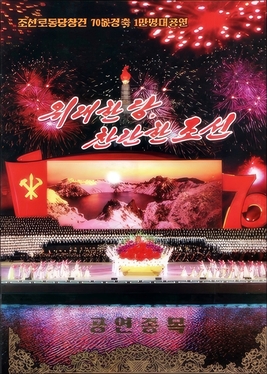
The 10 000 People Strong Grand Art Performance Celebrating the 70th Anniversary of the Workers' Party of Korea "Great Party, Rosy Korea" was a one-off artistic performance held on the 11th of October 2015 in celebration of the 70th anniversary of the ruling Workers' Party of Korea. The performance was originally meant to be hosted on the evening of the 10th of October, however, this was moved back a day due to wet weather.


























